
The southern platyfish, common platy, or moonfish is a species of freshwater fish in family Poeciliidae of order Cyprinodontiformes. A live-bearer, it is closely related to the green swordtail and can interbreed with it. It is native to an area of North and Central America stretching from Veracruz, Mexico, to northern Belize.

Mackerel is a common name applied to a number of different species of pelagic fish, mostly from the family Scombridae. They are found in both temperate and tropical seas, mostly living along the coast or offshore in the oceanic environment.

The king mackerelsurmayi or kingfish, is a migratory species of mackerel of the western Atlantic Ocean and Gulf of Mexico. It is an important species to both the commercial and recreational fishing industries.

Wobbegong is the common name given to the 12 species of carpet sharks in the family Orectolobidae. They are found in shallow temperate and tropical waters of the western Pacific Ocean and eastern Indian Ocean, chiefly around Australia and Indonesia, although one species occurs as far north as Japan. The word wobbegong is believed to come from an Australian Aboriginal language, meaning "shaggy beard", referring to the growths around the mouth of the shark of the western Pacific.

The Atlantic Spanish mackerel is a migratory species of mackerel that swims to the northern Gulf of Mexico in spring, returns to southern Florida in the eastern Gulf, and to Mexico in the western Gulf in the fall.
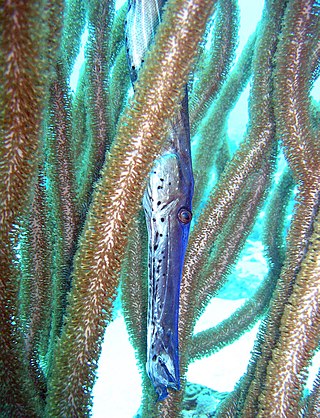
Aulostomus maculatus, the West Atlantic trumpetfish, is a long-bodied fish with an upturned mouth. It often swims vertically while trying to blend with vertical coral, such as sea rods, sea pens, and pipe sponges.
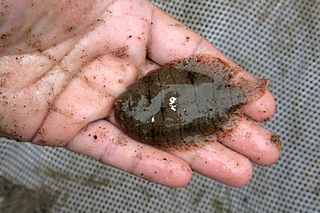
The hogchoker is a small species of flatfish found along the Atlantic and Gulf coasts of North and South America, ranging from Massachusetts to Venezuela. They prefer brackish water, and are abundant in many bays and estuaries north of the Carolinas. It is a member of the American sole family Achiridae. They are usually brown to dark brown in color, and lighter on their "blind side". The overall body color is often broken by a series of spots and thin stripes, which can be lighter or darker than the main body color. The fins and tail have fringed edges helping hide the fish from its prey. They mainly feed on small aquatic insects and invertebrates. They get their common name because East Coast fishermen would feed these so-called "trash" fish to their hogs, after which the fish would bow its body into a suction cup and stick to the soft palate of the hog, rather like peanut butter in a dog’s mouth.

Boraras is a small genus of Asian cyprinid fishes.

Pseudocyttus maculatus, the smooth oreo or smooth dory, is an oreo, the only species in the genus Pseudocyttus. It is found in all southern oceans at depths of between 400 and 1,500 metres. Its length is up to 60 centimetres (24 in).
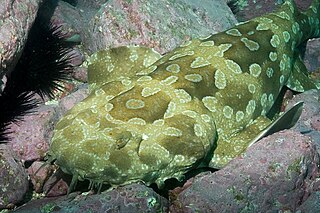
The spotted wobbegong is a carpet shark in the family Orectolobidae, endemic to Australia. It is a large, robust species, typically reaching 150–180 centimetres (59–71 in) in length. Coloured green, yellow, or brown, it has distinctive O-shaped spots throughout its body. It is nocturnal, resting at day and feeding on fish and invertebrates at night. An ovoviviparous species, the spotted wobbegong gives birth in the spring, during which time males can act aggressively towards other males and females. It has been known to bite humans, sometimes unprovoked, which can produce severe wounds. The species is fished commercially in Australia, but it is not severely threatened. It is listed as a least-concern species on the IUCN Red List.

The orange chromide is a species of cichlid fish that is endemic to freshwater and brackish streams, lagoons and estuaries in southern India and Sri Lanka. It is also known as pallathi in Malayalam. The species is popular with fishkeeping hobbyists, and is kept frequently in aquariums. The species is part of the family Cichlidae and is included in subfamily Etroplinae. The orange chromide reaches a length of up to 8 cm (3.1 in).
Parastegophilus is a genus of pencil catfishes native to South America.
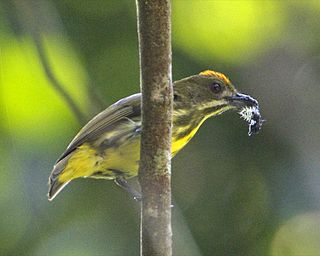
The yellow-breasted flowerpecker is a species of bird in the family Dicaeidae. It is found in Brunei, Indonesia, Malaysia, Myanmar, Singapore, and Thailand. Its natural habitats are subtropical or tropical moist lowland forest and subtropical or tropical moist montane forest.
The spotted lampeye is a species of poeciliid fish. It is native to the drainages of the Ruvu, Rufiji, Mbezi, and Wami Rivers in Kenya and Tanzania. This species grows to a length of 3.5 centimetres (1.4 in) TL. Its natural habitats are small rivers, brooks and swamps. This species is also found in the aquarium trade.

The least rasbora or exclamation point rasbora is a species of ray-finned fish in the genus Boraras, native to freshwater habitats in mainland southeast Asia. This species is very small, ranging from 12 to 16 mm.

The taillight shiner is a species of freshwater fish in the cyprinid family. It is commonly found in the south-eastern USA.

Opsarius is a genus of fish. Its representatives can be found in a variety of countries in South East Asia. These countries include Cambodia, Laos, Thailand, Myanmar, India, and China. Certain species of Opsarius are considered endemic to their respective habitats; such as Opsarius cocsa and Opsarius maculatus which are endemic to India.
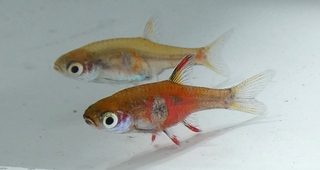
Boraras naevus is a fish in the family Cyprinidae endemic to Thailand. Its locations include swampy areas north of Surat Thani, the Tapi River drainage, and the Andaman Sea slope of the Malay Peninsula near Trang.
Alburnoides maculatus is a species of small freshwater fish in the family Cyprinidae. It is endemic to the Crimea Peninsula.

















